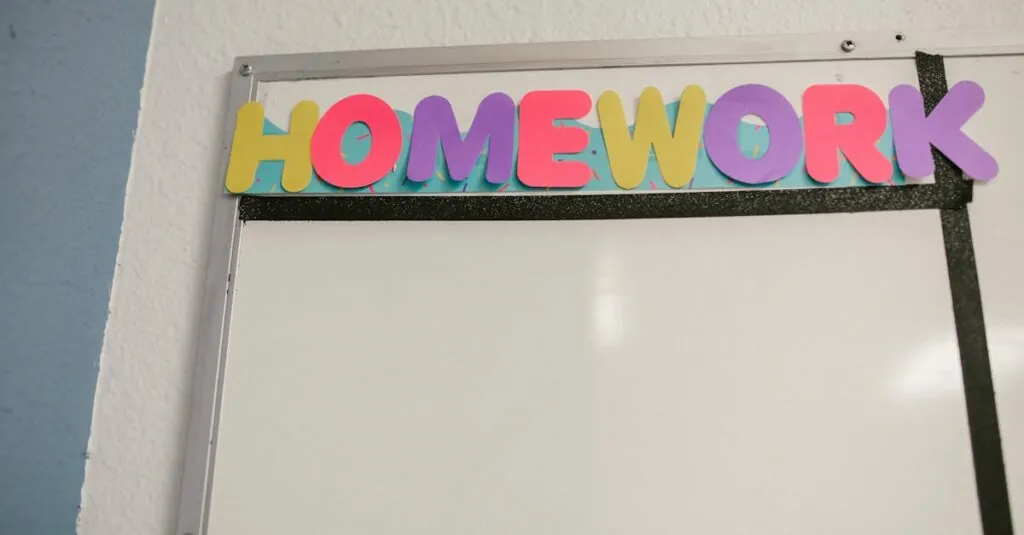Table of Contents
ToggleWhen it comes to American Sign Language (ASL), clarity is key. Imagine trying to order a pizza and accidentally asking for a pet iguana instead. Yikes! In the same way, signing “yesterday homework I study finish” is like mixing up your toppings—it’s just not right.
Overview of ASL Grammar
ASL grammar follows distinct rules that differ significantly from English grammar. Specific word order plays a crucial role in forming clear and coherent sentences. Typically, the subject precedes the verb, followed by the object. For instance, instead of saying “I eat pizza,” the ASL equivalent rearranges to “pizza I eat.”
Nouns and verbs need specific markers to convey tense. For past actions, ASL often requires adding time indicators, such as “yesterday.” Without these markers, confusion arises, as seen in the example “yesterday homework I study finish,” which miscommunicates the intended message.
Modifiers also enhance clarity in ASL. These may include adjectives and adverbs, which should be placed before the noun or verb they modify. For example, “big dog” translates as “dog big” in ASL. Such arrangements ensure the message remains understandable.
Additionally, facial expressions and body movements are integral to conveying context and emotions within ASL. They add nuance that words alone cannot express. Different facial expressions can indicate questions, excitement, or hesitation, adding an extra layer of meaning to signs.
By adhering to these grammatical principles, signers can communicate effectively in ASL. Correct structuring avoids misinterpretation while enhancing the flow of conversation. Learning these rules leads to better language comprehension and fosters clearer interactions in social settings.
Common Mistakes in ASL
Clarity in ASL hinges on correct usage of grammar. Misunderstandings often arise from simple errors, emphasizing the need to grasp ASL’s unique structure.
Understanding Time Indicators
Time indicators provide essential context in ASL. They indicate when an action occurs, shaping the meaning of a sentence. Signs for “yesterday,” “today,” and “tomorrow” serve as critical markers for tense. To enhance clarity, position time indicators at the beginning of a sign sequence. For example, in “yesterday homework I study finish,” the absence of a time indicator leads to confusion. Incorporating “yesterday” at the start ensures the sentence reflects the intended timeframe, allowing the audience to understand the action accurately.
The Role of Subject-Verb Agreement
Subject-verb agreement is vital for maintaining grammatical integrity in ASL. The signer must ensure that the subject and verb align cohesively. Incorrect constructions, such as omitting the subject or verb, result in unclear communication. For instance, in ASL, the appropriate structure follows “subject first, verb next.” In the phrase “homework I study finish,” placing the subject correctly clarifies the message. Each component should relate seamlessly, ensuring the sentence conveys a coherent thought. Proper subject-verb agreement shapes effective interactions and helps avoid common pitfalls in ASL communication.
Sign Language Structure
Understanding the structure of American Sign Language (ASL) enhances communication. ASL grammar differs significantly from English grammar, requiring attention to word order and syntax.
Sentence Construction in ASL
Constructing sentences in ASL relies on a specific word order. The typical sequence includes the subject followed by the verb and object. For example, instead of saying “I eat pizza,” sign “pizza I eat.” Placement of time indicators at the beginning of a sentence, like “yesterday,” establishes context and clarifies the timeframe of actions. Common errors include omitting these indicators, which can confuse the intended meaning.
The Importance of Clarity and Context
Clarity plays a crucial role in ASL communication. Incorporating time indicators and maintaining proper structure helps eliminate misunderstandings. Signers convey precise meanings through appropriate modifiers, ensuring descriptions and details match their intent. Contextual cues, like facial expressions and body movements, enrich interactions, providing additional layers of information. Mastering these elements allows for effective communication and fosters better understanding in social settings.
Why the Phrase is Incorrect
Understanding ASL involves recognizing specific grammatical elements. Clarity hinges on proper word order, which differs fundamentally from English.
Analyzing the Components
“Yesterday homework I study finish” lacks the necessary components for clear communication. The phrase misplaces the time indicator “yesterday,” creating confusion about when the action occurs. A subject, “homework,” needs appropriate alignment with verbs. Establishing a clear relationship between “I” and “study” through proper grammar is essential. Furthermore, the structure fails to indicate completion, leaving the message vague. In ASL, a clear sequence helps convey accurate meaning to the listener.
Suggested Corrections
To correct the phrases, reorder the components for clarity. A more accurate sign would be “yesterday I finish homework.” This sequence places the time indicator at the start, providing immediate context. Clarity improves with “I finish homework yesterday,” emphasizing completion. Each version aligns the subject, verb, and object clearly, fostering better understanding. Signers must implement correct grammatical forms to avoid ambiguity and facilitate effective communication in ASL.
Understanding the nuances of American Sign Language is essential for effective communication. Missteps like signing “yesterday homework I study finish” can lead to confusion and misinterpretation. By adhering to ASL’s grammatical rules and structure, signers can convey their messages clearly and accurately.
Utilizing proper word order and time indicators not only enhances clarity but also enriches interactions. As individuals become more familiar with ASL’s unique syntax and expressive elements, they’ll foster better understanding and connection within the deaf community. Mastering these aspects ensures that the intended message is communicated without ambiguity, paving the way for meaningful conversations.





